Panasonic executive interview, Part II: GH4 details, 4K isn’t just for video, and lots of reader questions
posted Tuesday, June 17, 2014 at 3:04 PM EDT
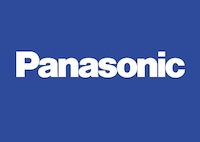
While I was in Japan for the annual CP+ show last February (yes, I'm that behind on my postings), I had an opportunity to sit down for an extensive discussion with two Panasonic representatives, Mr. Yoshiyuki Inoue and Mr. Michiharu Uematsu. Inoue-san is a very senior product planner for Panasonic, and Uematsu-san plays a very active role in communicating about Panasonic's new products with the press and Panasonic operating companies worldwide, as well as carrying product feedback to the planners and engineers in Japan.
The conversation went on for over an hour and a half, and the transcript ended up being over 9,000 words by the time I was finished with it. Given that extreme length, I decided to split the article into two parts. Part I went up over a week ago, and now here's Part II, to complete the story.
We'll pick up again with some discussion about the Panasonic GH4, their new flagship ILC, capable of 4K video recording entirely in-camera.
How did you manage to double readout speed for the GH4 sensor?
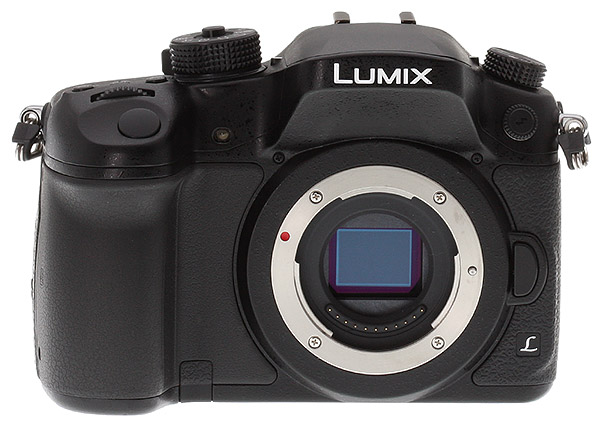
DE: I have other reader questions, but since we've started talking about the GH4, maybe I can ask some more technical questions about it. One of the changes with it is that the readout time for the sensor has been cut in half, relative to the GH3. How was that accomplished, what did they do on the chip to make that speed increase? Did they just have twice as many readout channels, or did they just clock the data out faster?
Uematsu: Actually, the interface between the sensor and the camera is digital, and the number of channels isn't open in the sensor spec.
DE: Oh, you can't say how many readout channels there are, then. You did say that the interface between the sensor and the processor is digital, though, so you're not sending analog data.
Uematsu: Yes, if we had analog data, then we'd have 8 or 16 channels, but that's done in the chip itself.
DE: Ah, so you're saying if you had analog readout, then the number of channels becomes important, but since it's digital, the number of channels isn't a factor?
Both: Yes, yes.
Uematsu: Actually more than 5 years ago, the Canon 20D I think had 8 channels, because that was in the analog era. But now it's digital, and such internal specs aren't disclosed, unfortunately.
DE: OK, understood. And of course, digital readout has a lot of other advantages as well, such as decreased noise and that sort of thing. So that increased readout speed, I would think that would make a significant difference for rolling shutter artifacts. Basically, with twice as fast readout, you should have half as much rolling shutter, is that true?
Inoue: Frankly, according to the customer feedback, they don't mention rolling shutter so much.
Uematsu: Especially in silent mode, we don't use a mechanical shutter. [I'm a little unclear on this; I was thinking in terms of video, but the mechanical shutter is only used in still-image recording anyway, so perhaps we were talking slightly at cross-purposes.]
Inoue: The customers have welcomed silent shutter.
DE: Ah, so customers are aware of the silent shutter mode as a benefit, but don't seem to be as aware of rolling shutter as a downside? Maybe it's because, at the consumer level, smart phones have terrible rolling shutter; the whole image wobbles and sways.
Both: Yes, yes.
DE: So if consumers can accept that, then the level of rolling shutter on almost any ILC is going to be better anyway. I see. I would think that rolling shutter would still be a concern for professionals sometimes, that they would want to keep it low.
Inoue: They would have to use the mechanical shutter, that's the only way to solve rolling shutter.
DE: But in video, you're not using a mechanical shutter at all, right?
Inoue: Yes, of course.
DE: When I think of rolling shutter, I think of it in terms of video, where the whole image wobbles and gets distorted. [moving on, we'll just have to see how the GH4 behaves in terms of recording video, when we shoot with it]
DE: So besides DFD, is there other technology that might make its way into low end cameras, can you think of other benefits to the Lumix consumer line?
Inoue: Yes, ordinary improvements in the EVF and the rear LCD, the pixel times [refresh rate] will be better.
Uematsu: Especially the EVF, that's much, much better than in the GH3.
DE: Ah, so that's an area of improvement over the GH3, and that's now a component you have available to use in other cameras.
Inoue: Some are just cosmetic improvements, like the lock button for the mode dial and the dimple for the grip. Also a softer eyecup for the viewfinder. But these are just appearance or [missed the word]
DE: So just ergonomic differences. I really like the way the mode dial lock works, push-on/push-off. The way it toggles like that is very nice, rather than having to hold it down while you turn. Those designs have always been very annoying to me.
Reader question: Why body-based image stabilization in the GX7, but not the GH4?
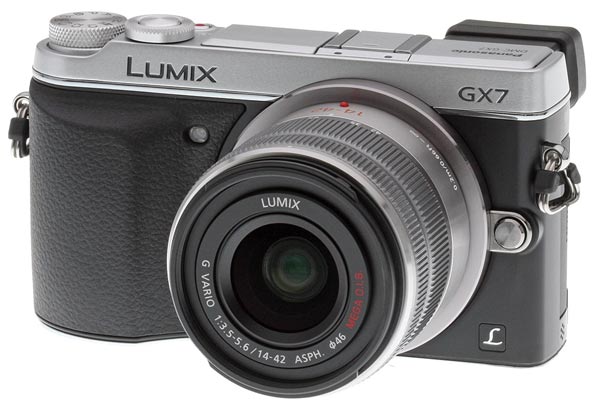
DE: This is something I didn't actually recall myself; our readers said that the GX7 has in-body image stabilization, but the GH4 does not have that. Is body-based image stabilization something that will only be in the GX series, or at least not in the GH? I suspect one reason why it may not be is because of noise, during video recording, is that the case?
Inoue: The main reason the GX7 was made with in-body image stabilization, was so people could enjoy the other lenses.
DE: Ah, so you were deliberately making that a platform that other companies' lenses could be used on?
Inoue: Yes, yes, this is the main reason on the GX7. But on this one [the GH4], there's an advantage to the heat sink for it to be stable. It's not impossible, but it's for a safety margin, to have a good heat sink. But many users have called for the GH series to have in-body stabilization, but for this one, we think it's better to not do that.
DE: So you have heard requests for in-body IS, but didn't feel it was a good idea.
Inoue: Yes, but I think it's not so big an advantage on this one...
DE: Yeah, on the GH4, you need to use Panasonic lenses with it, to take advantage of the DFD autofocus technology, which is a big feature- so its users will be more drawn to Panasonic lenses, many of which are image-stabilized anyway.
Inoue: Yes.
Reader question: Will 4K come to consumer camera models soon?
DE: Let me go back up to some reader questions again. I know you can't talk about specific products, but I'll try to turn this into a more generic one. Now that the GH4 has 4K, do you see that broadening, and other models in your line getting that capability at lower price points also, or is it really just a professional-level feature?
Inoue: At this time, we're thinking about it for the professional filmmakers, but as we proceed, 4K will become normal, so we'll have to implement it.
DE: So at some point, 4K will become the norm or standard, and at that point you'll need to offer it across the board. Yeah, my feeling (that was confirmed in talking with another camera company) is that TV companies are trying to make 4K the next 3D, trying to make it be a reason for people to upgrade their TV sets. [laughter] But I have to say I just don't see it. Again, this was in another interview, but I mentioned that, in our living room, we're sitting a ways away from the TV set, and even with regular HD, our eyes aren't good enough to see all that detail. So we went to a bigger TV, just to be able to see HD, and to be able to even notice the difference with 4K, it would have to be a very large set.
It's not just video recording, 4K output is important for viewing still pictures
Uematsu: Just thinking about the motion pictures, I think sometimes 2K is enough. However, almost all cameras we have now are more than 10 megapixels or 20 megapixels, and there's no solution to be able to see that. We have no output solution. And very few people make really big prints; other people just see their PC monitors. Also, if you make a very big print, it costs so much. So I think very high-end amateurs may want a way to see and present their pictures. Motion is very important, and even many manufacturers just think about motion, but 4K is not just motion, still pictures are more important, I think.
DE: Still pictures are more important for this market, then.
Uematsu: Yes. With a PC monitor, up to now, they've been less than 2 megapixels, and many people make just up to an A4 print [A4 paper is 210 by 297 millimeters or 8.3 in × 11.7 in, a bit narrower and taller than US standard 8.5x11 letter size], and 5 megapixels is enough for that. In that case, we have only two solutions. One is to make a very big print, the other should be a 4K TV or a 4K monitor. Especially TV manufacturers, they should promote 4K for not only motion pictures, but also for stills.
DE: Ah, they should promote 4K TVs not just for television, but as a way to see your pictures as well.
Inoue: For example this one is sakura [cherry blossoms] captured at 4K, and after that, downsampled for FHD. [showing me some images on an iPad with Retina display] This one is of a volcano, showing [they had difficulty translating the Japanese term, it turned out to be pyroclastic flow].
Uematsu: This can have academic uses. Even on a 10 inch display, with the newer screen [Retina display], you can see the difference.
DE: So even on a smaller screen, you can see the difference between 2K and 4K, you're saying.
4K recording isn't just for movies, it's useful for still photography as well
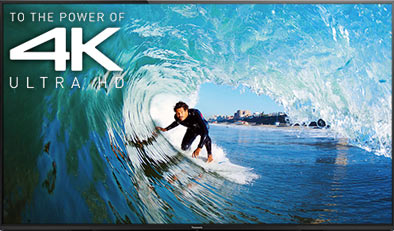
Inoue: This photo (showing an image on a Panasonic 4K tablet computer) was taken by Mr. Miyatake, he is a nature photographer who received an award from National Geographic in 2013, and he will display a photo exhibition in New York [May 28 - June 7, at the Steven Kasher gallery]. He mentioned that this is like an 8 megapixel picture, taken at 30 frames per second. So it's very, very useful for him, for nature photographers.
DE: So still photographers could use 4K to capture just the right instant, at 8 megapixels and 30 frames per second ...
Both: Yes, yeah.
Uematsu: Just so; still photographers have been thinking of motion pictures as not having very good image quality, because they were just 2 megapixels. But now it's 8 megapixels, so it's completely different.
Inoue: Maybe 10 years ago, there were only 6 megapixel still cameras, now we have 8 megapixels taken at 30 frames per second.
DE: That's very interesting; I think that that's a way that camera manufacturers like yourself should promote 4K. It's not just a motion picture, it's like a still camera with a super-duper motor drive.
Inoue: I agree with his opinion. Also, other test photographers mentioned the same thing.
Uematsu: Before I visited your office, I visited European countries, for the same purpose. [Initially briefing us on the GH4, before it was announced.] Visiting our sales offices, we prepared a 65-inch 4K TV, and also a 2K TV, and demonstrated the picture quality. And we said, even if we make an A3 size print at 300 dpi, six megapixels is necessary. [This assumes that you'd want a bit over half of the output device's resolution in the underlying data for best quality. A3 paper is 11.7 x 16.5 inches, so 175 pixels per inch in your image file would translate into a raw data size of about 5.9 megapixels. At the common US print size of 13x19 inches, the same resolution would translate into 7.6 megapixels of data.] However, you show only 2 megapixels, even with such a big screen. [at standard 1,920 x 1,080 Full HD resolution] When they saw the difference between 2K and 4K, they were very surprised at the difference in detail. And then ... it moved. [laughs]
DE: Oh, I see - you showed them a movie at 4K, just with the motion stopped, and then started playing it.
A new angle for TV makers? Surprising numbers of people view still images on their TVs
Uematsu: Yes, and I asked them to raise their hands if they used their TVs to enjoy their still images. And about 20% said yes.
DE: Really, 20% of the people said they were viewing their still images on their TVs?
Uematsu: Yes, 20%, this was in Germany. And they said "only 2 megapixels, really?" And this wasn't even on such a large screen.
DE: Wow, I had no idea the percentage would be that high. There's the connectivity issue of getting the images over there, but maybe that isn't as big a barrier as I've been thinking it was.
Uematsu: The important thing is that, of course, our Panasonic TVs have an SD slot, and other manufacturers don't have the SD slot. However, this [the GH4] is the only camera that has HDMI output supporting 4K. And not only for motion picture, but also still pictures as well. So it's possible to enjoy both at 4K.
DE: So if you're viewing a still picture from the GH4 over HDMI, it's being output at 4K resolution?
Uematsu: Yes, even with Sony and Toshiba. [big laugh from both]
DE: This is really interesting to me, it's giving me a whole different perspective on 4K, it can be a still-camera feature, too.
Uematsu: And already, they offer very reasonable prices on a 4K monitor.
DE: In Germany?
Uematsu: Yes, and in the US, too.
4K displays are finally affordable
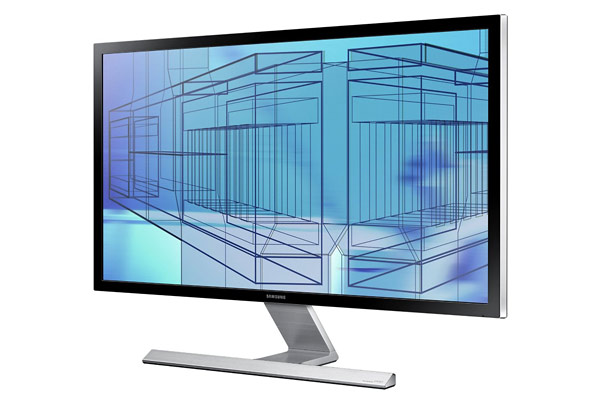
[Confirming that 4K monitors are finally affordable, I actually just bought a 4K computer monitor for the office a month or so back, so we'd have something to view 4K videos on. I got an amazing deal on a 28-inch Samsung U28D590, which we're very happy with. At the time, I bought it from an Amazon seller who shipped it direct from Korea, with no shipping costs and 2-day delivery(!) Now, Amazon carries it themselves, at $616.60 as of this writing ($80 less than I paid), eligible for free 2-day shipping to Prime members. For anyone looking for an affordable entry into 4K, I highly recommend it. It's a TN panel vs IPS, but the viewing angle and contrast actually seem quite good. Note that we're just talking computer monitors here, though; it'll likely be a while yet before 4K televisions get under $1K.]
Uematsu: And also, it's possible to connect with just HDMI [1.4a], to enjoy 4K.
Inoue: So, we're thinking about not only broadcasting, but also still pictures, with this innovation. If you buy just this camera, and just a monitor and a cable, you can enjoy 4K very easily.
Uematsu: And also, almost all types of cameras produce more than 4K content.
DE: So if the TV manufacturers promoted 4K for stills, that would kind of take care of the content problem; you wouldn't have the chicken-and-egg problem so much any more.
DE: So going back to my earlier question, about when we'll start seeing 4K in other parts of your line, it's really a matter of consumer demand.
Inoue: Yes, but our campaign for the US, about the "hybrid photographer," this camera is very suitable for that.
Uematsu: In the future, motion and stills should be simultaneous.
Inoue: This is our target.
DE: Ah - so any time you're shooting a movie, you're also shooting stills, basically.
Uematsu: Especially landscape.
What about a large-sensor successor to the LX7?
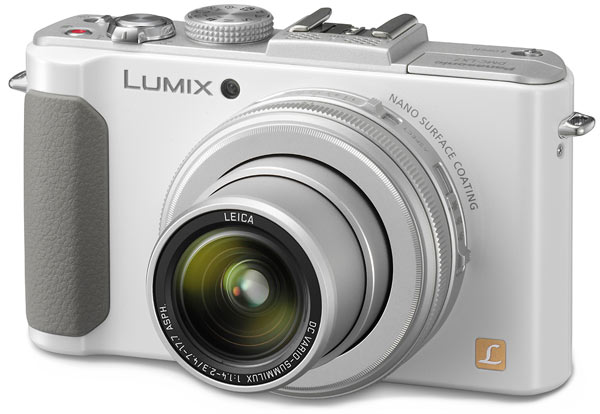
DE: Some readers were asking questions around an advanced compact camera like the LX7. Again, you can't comment on specific product plans, but two different readers asked about a camera like that, that started at a wider angle, like 24mm. Then there were also questions about the idea of a larger sensor. That's a 1/1.7 sensor, have you given any thought to the whole idea of big sensor/small body? You basically put a very big sensor in the GM1... I'm trying to think about how to phrase this, so you don't have to talk about specific product plans, in order to answer. I guess one question is whether you've considered a camera like the LX7, with either a wider-angle or brighter lens?
Inoue: Of course, we've considered a camera like that. Especially [missed the word] users have called us and said "you already make the GM camera" - they claim we can make a very, very compact...
Uematsu: Generally speaking, there's very tough competition with smartphones. So what should be our direction? A bigger sensor? I obviously can't say about future models, though. [both laugh]
DE: Yeah, that's an interesting point; when you start talking about a camera, where the primary feature is that it's very compact, then you're talking about smartphones. So even if you're talking about much better image quality, people always have a camera with them anyway, with their smartphone.
Uematsu: To make a difference between the camera and the smartphones, maybe that's a very good direction. Sony made a very good job of that. [laughs]
Inoue: The RX1.
DE: Yes, Sony's done very well in that whole category, and their 1-inch sensor cameras like the RX100 have been very successful, too, I think.
Any possible illustration for touch focus? "Touch focus has long been a feature of Panasonic cameras, a touch-screen feature we consider truly useful."
Reader request: Firmware update to improve Touch Focus and Auto Review behavior?
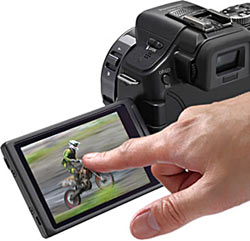
Touch focus is one of the few applications of touch screens on cameras I actually like. A reader suggests it could be made more effective, though.
DE: This isn't so much a question, as two requests about user interface from a reader. It's quite a lengthy request so I'll just read it to you:
IR Reader Paul: Here are 2 questions for Panasonic about their current UI:
While I'm enjoying my new GM1 and I am convinced this is one of the best cameras Panasonic has made to date, there is still some (unnecessarily?) annoying behavior of the firmware. The value of the GM1 in daily use could be increased by 100% for me and surely many other users if you would provide a firmware update. Both of my requests have to do with touch shutter.
"Touch Shutter" is an awesome feature many M43 cameras provide. Combined with the super fast AF Panasonic has implemented, it is terribly useful, when shooting with fast glass (i.e.. at shallow DOF). But unlike most other settings, the GM1 "forgets" that touch shutter was activated when powered off. As a consequence it needs to be switched on every time I switch on the camera. That costs time, and spoils many snapshot opportunities.
1) Is it possible (with a future firmware update) to let the camera remember the touch shutter on/off setting, when it is switched on?
[Some chuckling, Uematsu san says that he doesn't like touch functions, himself]
[Pause, and much discussion, while they play with a GM1 sample they had with them]
Uematsu: We'll consider that for a firmware upgrade.
[They couldn't themselves commit to doing a firmware upgrade, but these two execs are very key in the the product planning process, so I think there's a good chance that we'll see this in a firmware upgrade at some point, and likely become a standard feature on Panasonic models going forward. Big win for the users!]
DE: The second feature request this reader had involved the auto review function:
2) "Auto Review" is something indispensable in order to monitor what one is doing. But - of course - as it hides the live view, it is disturbing the flow of shooting. The problem is partly resolved, by forcing live view back on, as soon as the shutter button is half pressed. BUT ... if one is working mainly with touch shutter, auto review becomes really blocking. Disabling it is not a solution either, since that would mean, shooting blind. So a useful compromise other manufacturers have chosen is to offer options for 0.3s and 0.5 s of auto review. The GM1 only offers 1s, 2s, 3s, 4s, 5s.Could 0.3s and 0.5s as options (and probably sacrifice one or two of the longer options) be added with a firmware update?
[Several minutes of playing with the camera and discussion in Japanese]
Inoue: I appreciate the opinion and the very detailed request. I think this would also be useful for many users on our GH3. Thank you for your help!
[They were really very interested in this point, I think we'll almost certainly see future Panasonic cameras adopt this option, and wouldn't be surprised if it appears in a firmware update for the GM1 and possibly the GH3 as well. It unfortunately didn't make it into the GM1's version 1.1 update, released on April 24 of this year]
Reader question: Firmware update policy for current models
DE: Also in the area of firmware updates, another reader asks "Will Panasonic follow Fuji's trend and start to release new or improved functionality in their cameras with firmware upgrades? Theoretical examples might be clean HDMI output during movie recording or enabling image stabilization in movie mode in the GX7, focus peaking in the GH3, etc. Panasonic's firmware updates are only to solve bugs and to add compatibility with new lenses, whereas Fuji has done a very good job of adding functionality to existing cameras." This is something that's gotten a lot of attention from our readers; is that something you'd consider doing, or is it something you can't answer at this point?
Inoue: This is under consideration. We want to improve our products as much as possible, but sometimes the product that already exists may not be capable of it.
DE: So the hardware or architecture of some older products may not support certain features, like perhaps things like focus peaking, the GH3 hardware may not be capable of it.
Inoue: Yes
Uematsu: Of course, our resources are so limited, but this sort of activity is important to make Panasonic fans. This activity is very, very important to us, I think.
DE: So you see it as being important to turning people into fans of Panasonic. Yeah, I think this sort of thing is very important for users and for the brand, so people will realize that after they've invested in a product, they'll also receive the benefit of future developments wherever possible.
Uematsu: We've had so many interviews with professionals and regular users, and before that, we had many other interviews besides. From now, not only just now, but we have to continue to get responses.
DE: You need to continue to elicit responses from users?
Uematsu: Yes, because we want to have the lifetime of our products be as long as possible. To achieve this, such activity will be very important.
DE: Yes, it becomes a competitive factor, if products have a longer useful life. - I think I'm getting to the end of my list of questions... Oh, here's one that's a compliment, rather than a question, from IR reader SDX: "Thanks for putting the Stealth mode; in body image stabilization; dual control dials and articulating touchsreen into GX7. I can not imagine buying another camera without these features."
Both: Thank you very much!
Reader request: Don't crop RAW format when using non-4:3 aspect ratios
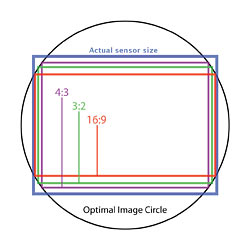
Some earlier Panasonic cameras varied both height and width to create different aspect ratios, but they no longer do so. A reader asks why they crop their RAW files to match the current aspect ratio selection. Wouldn't it be better to just always save the full sensor image?
DE: Here's another one that's kind of interesting: "Could Panasonic please stop cropping their RAW files to match the current aspect ratio setting, or is there a justification to keep doing this? If there's a justification to keep doing this, please consider adding a setting for people like me. I like to use the non-4:3 aspect settings for composition. Often I'm restricted and frustrated when I'm post-processing, because my framing might have been a bit off, or I might have forgotten to change the aspect ratio, like when I grabbed a quick portrait-mode shot when I was in 16:9 ratio, or I just changed my mind later." Is it true - I know in your earlier cameras, different aspect ratios used different parts of the image circle, which was very smart. Is that still the case, that the wide aspect ratio goes wider on the sensor's surface than the 4:3 aspect ratio does?
Uematsu: The GH1 and GH2.
DE: Yes, the GH1 and GH2 were examples. Do any current models still do that?
Inoue: This opinion we heard very much in Japan. [To not do aspect-ratio crops in the RAW files.]
Uematsu: Actually, we've heard many opinions on that.
DE: Is there a difficulty doing it, though?
Uematsu: One consideration is that, in that case, we have to make a special sensor. [I think he's talking about the way the GH1 and GH2 would change the maximum width and height of the image they were extracting from the sensor, depending on aspect ratio; I don't think this response is about not cropping RAW files in current models that don't have that behavior.]
DE: Oh, I see; the older cameras had different sensors.
Uematsu: Yes, a little bigger than Four Thirds, actually.
DE: So, in the current sensors, the other modes, the non-4:3 aspect ratios are just crops.
Uematsu: Yes, just crops.
DE: So, what this person is asking is that you'd be able to save RAW files that wouldn't be cropped, even when you were in 16:9 ratio mode, for example.
[Some discussion in Japanese]
Inoue: I understand, I've already had such an opinion. This is a difficulty for our SilkyPix application.
DE: Ah, so SilkyPix wouldn't know what aspect ratio to use.
Inoue: Yes, so we have already started to [couldn't understand the word]
Uematsu: We have to consider the communication between the camera and those applications.
DE: Does the RAW file have any metadata associated with it? JPEG has the EXIF header, with lots of ancillary data in it, does the RAW format have that sort of thing, too, or is it just "here's chunk of data"?
Uematsu: The RAW file also has a header, like JPEG.
DE: So it seems like you could just (well, easy for me to say "just") add aspect ratio data to the header and SilkyPix could read it. It doesn't seem that it should be so hard.
Inoue: Some users could be confused if, for example, the JPEG data was for 3:2, but the RAW data was the full pixel size. So, in SilkyPix, we'd have to have that consideration.
DE: Well, what if you made it a custom menu option in the camera? So you'd say full-frame RAW or cropped RAW, just let people choose? Then the people that wanted to do full-frame RAW could do that. Then make the default be cropped RAW, so people who didn't explicitly choose that wouldn't be confused, and people who'd made that change would presumably know that that's what they'd done, so they'd understand why their RAW files were full-frame.
Inoue: I think there's already such an opinion [within Panasonic], but at the present time we cannot. In the future, we will build such a specification.
DE: Like I said, if it was just a custom menu setting, it seems like that would be easy to do, just in firmware.
Inoue: Individual body [?], that would be OK, but we have to coordinate with SilkyPix.
DE: I guess I'm kind of arguing that, if it's a custom setting, you maybe don't need to coordinate with SilkyPix on it. Explain to people or tell them "look, SilkyPix will see this as a full frame, not cropped, then sometime later, you can get SilkyPix to fix it. It sounds like it would be something that again, this would be one of those firmware updates that could be done to give current users some added functionality. But you really feel like you have to have the SilkyPix update at the same time. My vote would be that it doesn't have to be at the same time, but I understand that that's your internal decision.
Crystal Ball: What's the future hold for the camera market?

It takes a crystal ball to see clearly what the future holds for the camera market. Panasonic believes that it will eventually stabilize at roughly film-era levels. *
DE: I guess the very last question has to do with the market. You know, for a long time, compact camera sales were dropping, but the interchangeable lens sales stayed up. But in 2013 apparently, the interchangeable lens sales dropped as well. Do you think that's just a temporary blip in the market, maybe just the global economy or something, or do you think it's a longer-term trend? One concern I've had in the back of my mind is that the cameras have gotten so good, maybe people won't feel the need to upgrade as often. But at the same time, there are still new people coming into the market. Looking into your crystal ball, what do you think is the trend for ILCs? Will they go back up again, hold steady, continue dropping slightly, or what?
Inoue: Our philosophy is that we should not decrease our efforts, especially in the interchangeable market. In order to keep the market size, we have to bring in other users. One of our ideas is "hybrid photography", to combine video shooting. On the other side, cameras like the GM1 are for new fashionable users. This kind of product's target user is female or younger female, who aren't [camera enthusiasts], but who want something fashionable.
DE: Yeah, they wouldn't carry a GH4 around their neck...
Inoue: Yes, yes. So we are considering what target users we're making the products for. We have to make very "charismatic" products.
Uematsu: Total capacity 20 years ago was around 50 million cameras in the world. However, three years ago, it was already over 100 million. I think it was some kind of a bubble. Finally, it will be around 50 or 60 million, and of course the ratio of the kinds of cameras will be somewhat different. The interchangeable lens types should be increased, and compact cameras should be a different shape than smartphones.
DE: So you said that in the film days, the total market was 50 million, and that's including compacts, SLRs, everything.
Uematsu: Yes
DE: And recently, it got as high as 100 million, but you think it will come back down to 50-60 million. You don't think it will come all the way back down to 50, though?
Uematsu: About 50, I think.
DE: Ah, so back to about where the market was in the film era. Then, the question becomes innovating, so cameras can justify their place alongside smartphones.
Uematsu: And also, I already said, we have to consider not only just producing cameras, but also offer how to enjoy the images. And so we actually have TVs, and PCs, so maybe the whole Panasonic group, we can do this, not only just cameras.
Inoue: Because the solution is not just the camera product, we have to provide the total solution. With 4K, for example, we have to provide the camera, the TV, the recorder, and so on.
Uematsu: Otherwise, normal consumers, they're just taking photos, and just see [he indicates the LCD on the back of the camera], no printing, that's all. It's a very critical situation, I think. We can sell very many cameras, but ...
DE: Yeah, people aren't doing anything with them. Of course, the big thing people are doing with pictures is sharing them on Facebook. It's kind of funny, because consumers feel that they have to have a 20 megapixel camera, but their pictures are all ending up a few inches across on Facebook. So WiFi is a really important part, for connecting to smartphones. And what the consumer wants, really, is to just take a picture and it automatically appears on their phone. They don't want to have to launch an application or anything. Do you think - I'm sure at some point, some day, that will happen, but do you have any idea when that time might be, and what the obstacles are to getting there? Will it be 2 years that we might see this happening automatically, or is it going to be 5 years? Do you have any idea?
Inoue: It's very difficult.
Uematsu: In two years, we almost certainly can't establish that situation.
DE: Oh, of course, you're working on cameras for two years from now right now, so you know what can or can't be done.
Uematsu: Maybe 2 or 3 years.
DE: Of course, the device makers, the smartphone makers have to be involved somehow, and it's hard to engage them.
Inoue: Until a few years later, some surprise may occur. I don't know such a thing, but I think for instance, Canon and Nikon. For instance, Nikon's main enterprise is just camera products, so they have already prepared for some collaborations. For example, the Nikon Capture is made by the Nik company, so they are already collaborating with others. So I think that's how to make a camera system capable [of this connectivity]. So they have already considered this kind of thing, and we have to do the same.
DE: So the key to it is collaboration.
Inoue: Yes, yes. I think collaboration is very important.
DE: Well, believe it or not, that's actually all my questions, and we really did take almost two hours. [everyone laughs] Thank you very much for your time!
* Crystal ball photo (c) Boris15 www.fotosearch.com Stock Photography